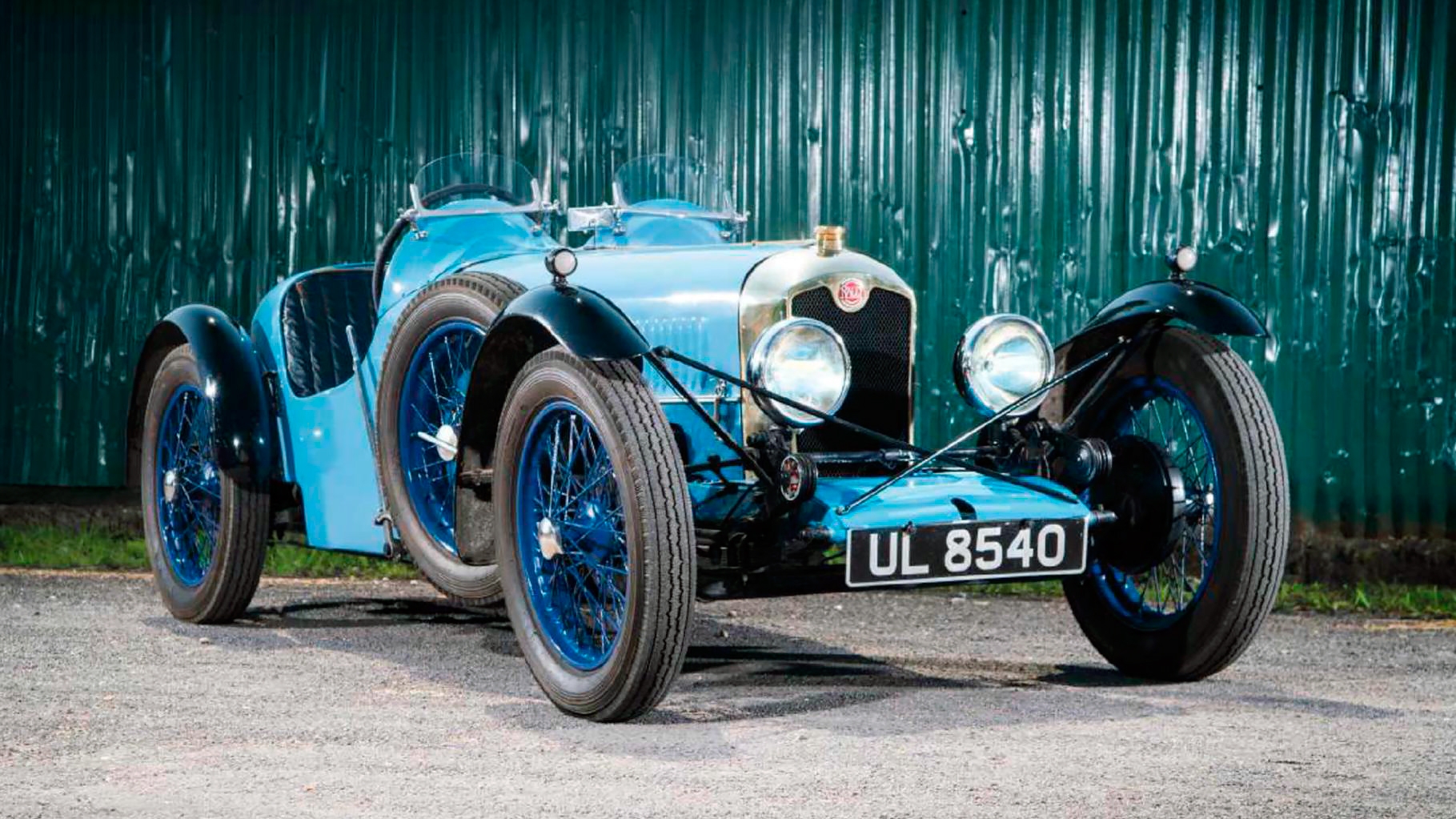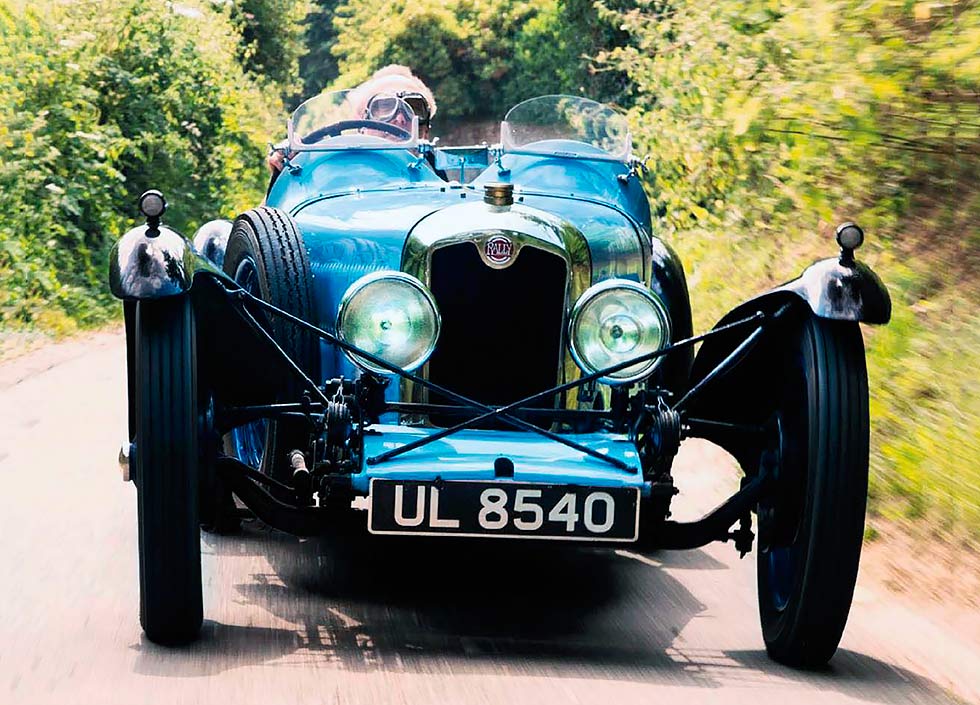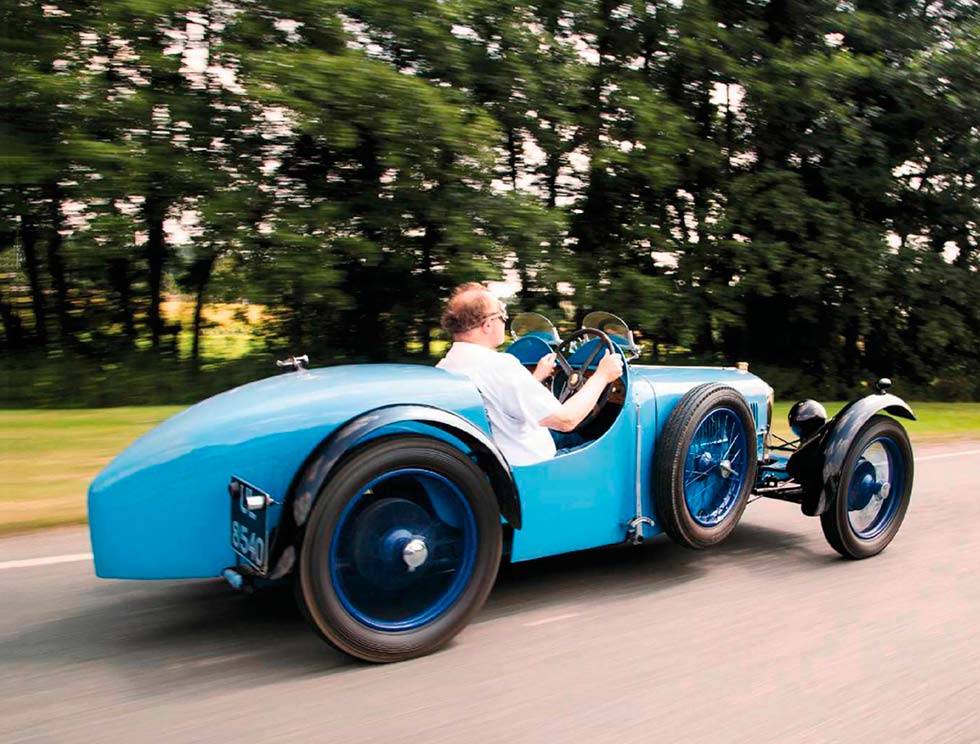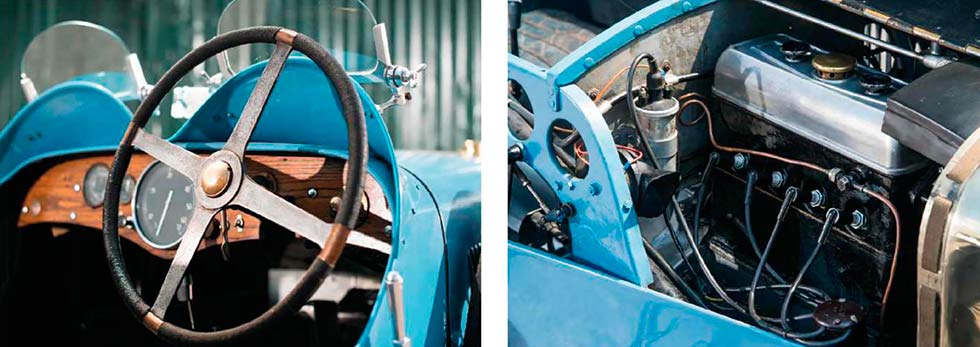
Rally ABC Around. Twenties veteran of trials, sprints, hillclimbs and the Brooklands Double Twelve so talented that it went on to inspire a generation of MGs. This rare French-built Rally ABC was first campaigned in the 1929 Brooklands Double Twelve. We take it back to the Sussex lanes to see what it will do today. Words Ivan Ostroff. Photography Eric Richardson.
So much has changed in the past 87 years, yet Jeremy Wood’s 1929 Rally ABC remains a timewarp car. Sitting in the driver’s seat of this unspoilt ex-Brooklands racer, eyes closed, I want to experience what it was like to drive this car back then. Pulling my goggles down over my eyes, I gaze down the long blue bonnet and soak up the atmosphere. Much of the Sussex countryside around here remains as it was then – and, in my mind at least, I’m back in 1929.
With the French-built 1084cc SCAP (Société de Construction Automobile Parisienne) four-cylinder engine chugging sweetly at a steady 700rpm, I push down on the ABC’s clutch for the first time. It’s extremely heavy, but not as aggressive as I expected – in fact it’s progressive and quite the opposite of an Austin Seven, for example, which is either in or out. The gearlever has a fairly short throw and I locate first easily. The Rally has just three forward ratios, with first sitting left and back, in the position of second on modern cars. Reverse is straight forward, opposite first. It too engages easily and after turning the car around I cautiously steer the Rally out of the yard.

Still in first, I turn on to a lane that also can’t have changed in 87 years. There’s no synchromesh up or down, which leaves two options: if you know how to double-declutch properly, you can drive this car; if you don’t know, don’t even bother to start the engine. I move the lever forward and across the gate, bring my left foot up, then down again, before sliding the lever forward into second to engage drive once more with a most satisfying silence apart from the gears softly meshing.
Repeating the procedure when 2000rpm registers on the immense central tachometer, I shift up once again into top. Considering the period of the car, the gearbox is a delight to use. Although a little notchy, the linkage works with remarkable precision and no slack. Don’t forget the layout of the gearbox gate, though, or you may inadvertently go straight from first into reverse with suitably gruesome consequences. Happily, I don’t.
The Rally is rather high-geared so I need to get some revs up and then only change up once it has gathered speed. But once in top it motors along nicely. The scuttle is quite high, the aero screens work well and there’s surprisingly little buffeting from the airflow.
There’s no speedometer, which makes judging how fast the car is moving a challenge. However, knowing that every 1000rpm in top equates to 19.0588mph helps a lot – calling it 20mph for simplicity, you quickly learn to make a rough mental calculation. At 2500rpm – about 50mph – the ABC seems to enjoy breaking into a run, enabling me to focus on soaking up the experience without having to worry about breaking the 60mph speed limit.
There are half-elliptic leaf springs on all four corners and the ride is controlled with the aid of adjustable Hartford friction dampers. The seat is comfortable enough when the car is stationary, but on the move it’s quite unable to compensate for the hard-as-rock suspension.
There’s no play in the steering box, but there’s a certain vagueness when motoring straight ahead and the car does tend to jump about. Bounding along the bumpy Sussex lanes, the Rally leaps into the air at the slightest provocation – which maybe explains the altimeter on the left of the dashboard.
The handling might sound a bit grim, but that’s certainly not the case – such characteristics are to be expected with this era of machine and I just have to be careful not drive too fast along bumpy roads if I want to stay in the car. One positive result of the stiff suspension is that there’s virtually no roll going through corners, making this live front axle car unbelievably enjoyable to drive.

1929 Rally ABC road test
The front brake drums are not finned like the rears, but retardation is progressive with lots of feel and plenty of bite. In fact the rodactuated system stops the car more efficiently than I could possibly have imagined. The skinny 450×19 tyres grip well on all four corners and don’t allow it to get skittish or plough straight on as I hammer through fast bends. The steering remains light and the front bites nicely without threatening to drop into an understeer disaster.
Before long I’m leaning out, hanging on to the big sprung and strung wooden steering wheel, enjoying the rasp of the exhaust note as I accelerate out of the bends like I‘m on a charge at Brooklands. With elbow and head well over the side of the car, I look across the corners in the direction of travel and really get to grips with the feel of the car as the tail jumps sideways and I intuitively correct it with a twist of the wheel.
I suddenly realise I’ve taken a wrong turn. But unlike a modern racing car the Rally’s turning circle is particularly good – moving the steering wheel at low speeds is hardly difficult on those narrow tyres and selecting first and reverse gears is easy. Turning the car round in quite a tight space is a doddle.
Back on course again, I look down the long blue bonnet, watch the front wheels jump about and feel grateful that the rear end is so well behaved. ABCs were built with no rear differential and instead had a Perrot Piganeau axle as fitted to some of the more important French racing cars of the late Twenties. It was fine for Brooklands, where the corners weren’t very tight, but on more demanding bends it would have worn the tyres quickly. This ABC, however, has a special back axle with a differential, which owner Jeremy Wood believes was fitted by racing driver Jack Driskell when he was preparing the car for the Brooklands Double Twelve. The finned rear drums are likely to have been fitted at the same time. More about Driskell and his exploits later.
Eventually I get used to predicting the car’s reactions to the bumps and undulations of the various road surfaces and I can’t help grinning with delight – the Rally ABC at any speed is terrific fun, but driving it even briskly is absolute magic. So how did it come about?
Rally was a small French company based in Colombes, north of Paris. It originally made small cyclecars but in 1927 started building the ABC – the name is thought to be a pun on the French word abaissé, meaning to lower, in this case referring to the underslung chassis. The model was first fitted with Chapuis-Dornier engines, then Ruby units and finally with the 1084cc overhead-valve SCAP powering this car.
At most only 100 of these cars were built. As well as the normally aspirated ABC, a supercharged model was advertised with a Cozette supercharger bolted on to the SCAP engine. Rally ceased car production in the mid-Thirties.
In 1929 ex-Indian Army major JA ‘Jack’ Driskell, along with Lewis Cutbill Jnr, imported two ABCs and immediately entered them in the London-Land’s End Trial. Driskell drove a blue ABC named Moulin Bleu and registered VLU 5889 and Cutbill drove this car, UL 8540. Being red, it was inevitably dubbed Moulin Rouge. Both ABCs won silver medals on the Land’s End trial and were sold shortly after.
Night racing was banned at Brooklands, which could therefore not host 24-hour races like Le Mans. To get round this The Junior Car Club came up with the idea of the Double Twelve event – drivers raced for 12 hours on Friday, their cars were impounded overnight, then they raced for another 12 hours on Saturday.
In May 1929 Driskell bought back UL 8540 and prepared it for the Brooklands Double Twelve. He fitted the special back axle and differential mentioned previously, plus a large tachometer in the driver’s cowl and a long-range fuel tank with a filler in the tail. The car broke down on the first day of the race with a holed piston, and the engine had to be dismantled. It was running again an hour into the second day and completed the course. Driskell said afterwards that it was managing 88mph, but no official records of his finishing position are known to survive.
The ABC then had a number of owners before Driskell again bought it back in early 1933. He painted the car pale blue and campaigned it in sprints and hill climbs throughout that season, selling it yet again at the end of the year.
In 2014 Jeremy Wood spotted a small ad for a Rally being offered for sale on behalf of a client by a classic car garage in Glasgow. At the time he was completing his book Speed on the Downs – Lewes Speed Trials 1924-49 and was aware of Driskell’s ABC. He even had a photo of him leaving the Lewes start line in the car in 1933. Wood called the dealer and asked about the car’s registration number. The reply was UL 8540 – the same as that in the photo. ‘I jumped on an aeroplane next day and flew up to Glasgow,’ says Wood. ‘It looked fairly presentable but wasn’t running very well – but I simply didn’t care and bought it immediately for £20,000.’

1929 Rally ABC
The Rally had been standing in Perthshire’s Doune Motor Museum for more than 25 years and hadn’t been driven for a very long time. Fortunately, it hadn’t been messed about with much either, but Wood soon realised that the radiator surround was totally wrong – it was a flat, chromed moulding that spoiled the whole appearance of the car. All post-war photos of the ABC show it with this replacement unit, but pre-war pictures show it with its original, correct radiator. Wood surmises it was probably taken for scrap during World War Two. ‘Luckily I managed to borrow the correct radiator from a sister car to use as a pattern and after much work a replica was made from the correct German silver.’
Rallys were fitted with a metal dashboard when they left the works, but an early photograph of this example in the pits at Brooklands shows what appears to be a wooden dash, so the one on this car almost certainly isn’t original. The instruments are those fitted by Driskell himself. ‘He obviously made a much bigger cowl and put the rev counter in it so that he could see it clearly when he was racing,’ says Wood. ‘The instruments are mostly by Jaeger, but even though this is a road car it has never been equipped with a speedometer. I believe that by 1933 it had acquired its English oil pressure gauge because who would have understood kilograms per square centimetre in those days? The ammeter too would probably have been acquired later, so I had to decide whether to put it back to how it was in 1929 or to keep it as it was when Driskell raced it in 1933. I felt that by now these items had become part of the car’s continuing history, so after some consideration I decided on the latter course.’
When new, the ABC’s SCAP engine had a reputation for being lively but fragile and suffering from porous cylinder blocks, so Wood had to make a concerted effort to restore the one on this car. ‘Historic cars are rather like historic homes – if we’re fortunate enough to own one we are merely its custodian during the period of our ownership and have a duty to pass it on to future generations in as original a condition as possible.’
He adds, ‘You would have expected the bonnet to be made of lightweight aluminium but it’s actually steel and so heavy that it requires pretty good muscles for one chap to lift it off without any help. Many restorers would have probably replaced it – and possibly the body too – with lighter panels as well as making a new crankshaft, conrods, engine block and cylinder head. The car would have looked exactly the same and probably been more reliable into the bargain – but it wouldn’t have been original.’
Second gear had sustained a considerable amount of wear, and when Wood bought the car the gearbox needed a complete rebuild. He took it to East Sussex-based specialist Neve Engineering, which did a superb job of remaking all the gears.
It had also been fitted with plastic seats, so Wood bought leather replacements from a 1933 Riley Kestrel. ‘I had to modify them slightly, but they look really in keeping with this period of motor car. It also had a non-original steering wheel but I managed to find this appropriate four-spoke wheel at Beaulieu – it’s a genuine French René Thomas wheel of the type fitted to a number of French racing cars in the late Twenties and early Thirties. Being sprung, it has the correct period feel and looks right.’
In period the Rallys came with a fourgallon gravity-fed fuel tank fitted between the dashboard and the back of the bulkhead. This car has a larger one fitted in the tail and appears to have been installed quite early on in the car’s life, fitting in with the modification made by Driskell. ‘It supports the belief that it was the very car that ran in the Double Twelve race,’ says Wood. ‘You certainly don’t go into something as gruelling as a 24-hour race with a four-gallon fuel tank!’
Wood enjoyed two particular strokes of luck while restoring the Rally. The first came when he managed to locate and speak to the owner of a sister Double Twelve car in the Midlands – and learned to his surprise and delight that Ralf Silva, Driskell’s riding mechanic, was still alive and living in Ringwood.
‘Naturally, I was keen to get in touch with Ralf and found him to be the most delightful man,’ says Wood. ‘He told me that he was apprenticed to Driskell in 1933 at the age of 17 and had come to this country from Italy before getting the job through a friend.’
The Rally was one of the first cars he had worked on with Driskell. Ralf was his riding mechanic when he competed in the Lewes Speed Trials, the Chalfont Hill Climb and at Brooklands in the JCC Rally, the High Speed Trial and a relay race. Ralf still had photos of the Rally in all the Brooklands races in which he and Driskell took part. Sadly, Ralf has since died, in his nineties.
The other stroke of luck happened when a friend of Wood happened to discover a medal won by Lewis Cutbill in a Rally ABC at the 1929 Land’s End Trial. Knowing how passionate Wood was about Rallys, he asked if he would like to buy it and he picked it up for just £30. ‘I didn’t know at the time that it was related to my car in any way, because it was given to Lewis Cutbill, who was the other driver in the team. However, I have since established that he and Driskell actually swapped cars for that event and there is a photo of Cutbill in my car to prove it – so the medal is now rightfully back with my car.’
Thanks to: Goodwood
TECHNICAL DATA 1929 Rally 1 1/10 Litre Type ABC Voiturette
Engine 1084cc, in-line four-cylinder, ohv, pushrod, two valves per cylinder, single bronze sidedraught one-inch SU carburettor
Power and torque Unknown
Transmission Three-speed manual plus reverse, rear-wheel drive
Steering Worm and sector
Suspension Front and rear: live axle, half-elliptic leaf springs, Hartford friction dampers
Brakes Drums front and rear, rod-actuated
Weight 650kg (1433lb)
Performance Top speed: 85mph; 0-60mph: unknown
Value now £82,000
The ABC’s long bonnet and short scuttle could well have influenced the design of a generation of MGs.
Tapered tail houses a long -range fuel tank fitted for 1929’s Brooklands Double Twelve 24-hour race Period-correct René Thomas wheel restores the correct feel.
Restored 1084cc SCAP pushrod engine is still a sparky performer.
INSPIRATION FOR CECIL KIMBER AND MG
Two more ABCs are thought to have come to England. One was owned by an AS Gordon and competed once at Brooklands, the other was bought around 1930 by MG creator Cecil Kimber.
Photos in The Art of Abingdon by John McLellan show Kimber’s car partly dismantled at MG’s Abingdon works. ‘It seems it was bought secondhand then taken apart for examination,’ says Jeremy Wood. ‘Several ideas were borrowed for MGs – in particular, the long bonnet and very short scuttle that allowed better access to the pedalbox, pedals and the back of the gearbox, thus making the cars much easier to work on. I don’t know another car with those features at that time. After driving the Rally, Kimber was probably convinced by other good features such as the underslung axle and sliding trunnions.’
‘Before long I’m leaning out, hanging on to the big steering wheel and enjoying the rasp of the exhaust as I accelerate out of the bends like I’m on a charge at Brooklands’
“There’s no speedometer, but knowing that each 1000rpm in top equates to 19.0588mph helps you to work out roughly how fast you’re going”





